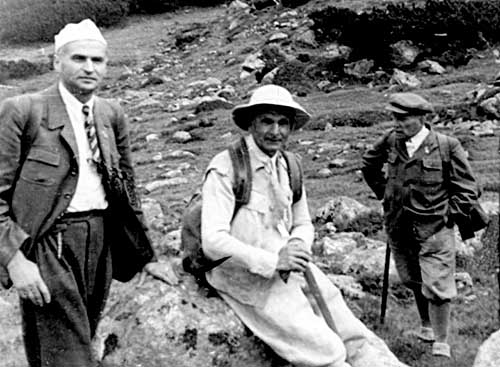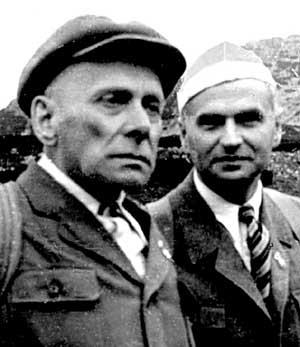.
Last year, Józef Nyka, mountaineer, longtime editor of Taternik, and author of numerous guidebooks for Tatra Mountain enthusiasts, wrote an article about a forgotten figure in Polish mountaineering, my great-uncle Marek Korowicz. It turns out that Marek, whose experiences as a professor of international law and Cold War political refugee I have related here before, was also a keen mountaineer. I wrote to Pan Nyka, over at Głos Seniora and he kindly gave me permission to translate his article about Marek and publish it here, along with photos (hats off to trekking in suits and ties!) from the collection of another well-known custodian of Polish mountain culture, the late Czeslaw Bajer.
Thank you, Pan Nyka!
.
“This year marks the fiftieth anniversary of the death of Dr. Marek Korowicz, prominent political scientist and commentator, but also exemplary organizer and early advocate of mountaineering in Cracow and Silesia. He had no farewell in Taternik [publication of the Polish Mountaineering Union] and his name does not appear in WET [Zofia Radwańska-Paryska’s and Witold Henryk Paryski’s Great Tatra Encyclopedia] or WEGA [The Great Encyclopedia of Mountains and Mountaineering]; so let us save his memory from oblivion in our humble columns.
.
.
He was born on 11th March 1903 and completed his education in law (Doctor of Law). His father was Joachim Kornreich-Korowicz and his elder brother was the well-known professor of economics Henryk, who wrote under both names Kornreich and Korowicz and who was murdered by the Germans in Lwow in 1941. While studying law at the Jagiellonian University, Marek got together with a group of Tatra mountaineers.
.
In 1922, Korowicz, John Durr, and John A. Szczepanski decided to create in Cracow a mountaineering organization for students. A draft was prepared by Durr and the future lawyer Korowicz and after some discussion it was submitted to the President of the Academic Sporting Union, prof. Walery Goetel. In October 1923, the Academic Sporting Union established a mountaineering section (ST AZS), in which Korowicz assumed the functions of registrar.
.
In October 1924, he was admitted to the Mountaineering Section of the Polish Tatra Society [ST PTT]. He climbed with his Cracow colleagues. Paryski mentions his name eleven times. On the 9th of April, 1924, together with Adam and Marian Sokolowski, he crossed the ridge from Swinicka Pass across both peaks of Swinica and further on to Zawrat. During the climb, Niebieska Turnia had its first winter ascent (the lower Swinica peak had earlier been climbed in winter by, among others, Borys Wigilew). In July 1924, together with Jan K. Dorawski and Stanisław Sluzewski, Korowicz participated in the first crossing of the northern wall of Hruba Turnia and on the 20th of July, 1924, he accompanied Dorawski and Mieczysław Szczuka to the lower part of the eastern wall of Mięguszowiecki Grand Peak (WHP 892) before their famous sixth Variant D. On August 6, 1926, he took part in an attempt by the central route on the northeastern wall of Rumanowy Peak, his fellow-climbers including, among others, Dorawski, Szczuka, and Marian Sokolowski. He also climbed in the Alps.
.
Marek began his work in Katowice in the 1930s and immediately became active in promoting local mountaineering, laying the foundations for Silesian alpinism. Already in 1933, we see him on the board of the Upper Silesian branch of the Polish Tatra Society in Katowice and on his initiative, in 1933, the Upper Silesian Mountaineering Section was formed within the Polish Tatra Society with Marek at its helm. Its members aimed to create Katowice’s first Mountaineering Club Federation, which came into being only after the war. Lectures were organized with Korowicz entertaining audiences with accounts of winter ascents in the Tatras and wanderings in the Swiss Alps.
.
The Alpine Section was the first mountaineering organization in Silesia and this year the Katowice Mountaineering Club should be celebrating its eightieth anniversary. During the war, Korowicz was active in the resistance, and under the pseudonym ‘K.M. St.’, penned many pamphlets and articles, including his famous essay Poland among the Nations of the World (1942). After the war, he was an active participant in Mountaineering Club conventions. In spring of 1948, he organized a festive evening in honour of the doyen of Polish mountaineering, 70-year-old Janusz Chmielowski. He gave a course of lectures in mountaineering (April 20 – June 2) which introduced 30-40 students to varied topics including topography, philosophy, history and organization, equipment, technical climbing and mountain rescue. In February 1949, at Marek’s initiative, a founders’ meeting took place in Katowice, where attendees called for the establishment of the Upper Silesian Branch of the Polish Tatra Society Mountaineering Section, and on 12th October, 1949, it came into being. Writing in 1952, Franciszek Klosinski mentions Marek as “the founder and first chairman of the Silesian Mountaineering Society’. He continues: “During a period of intense activity of the Society, with theoretical courses in mountaineering, Marek was called to a professorship at Curie-Sklodowska University in Lublin, and with great regret, resigned his role as chairman on May 17, 1951.” In those years, Korowicz climbed with, among others, Chmielowski i Czeslaw Bajer (in August 1948 with variants on Pościel Jasińskiego). On September 6, 1948 a new route on Przelecz Nowicki was recorded, with Korowicz, Paryski, Dorawski, Danuta and Maciej Mischke, and Tadek Giewontem as guide. Marek’s notes in Taternik are signed ‘MSK’. Czeslaw Bajer recalled Marek as a pleasant companion, physically fit, and a true mountain lover.
.

Marek Korowicz (left) with ks. prof. Tadeusz Kruszynski i Janusz Chmielowski in Dolina Stawów Gasienicowych, 1949. Photo Czeslaw Bajer.
.
As an academic, before the war, Korowicz worked on the issue of nationalities in Poland, and in 1938, published Upper Silesia and the Protection of Minorities, 1922-1937. After the war, Korowicz was appointed professor of Socio-Economic Sciences in Katowice. He later became a professor of International Law at Lublin University and subsequently, a lecturer at the Jagiellonian University. He published several major works, including Czechoslovakia Yesterday and Today (1948) and The Sovereignty of Members of the United Nations Organization (1949). The National Library catalogue includes 40 of his publications, mostly devoted to Silesian affairs, as well as works dealing with Slovakia and Czechoslovakia.
.

Leave a comment